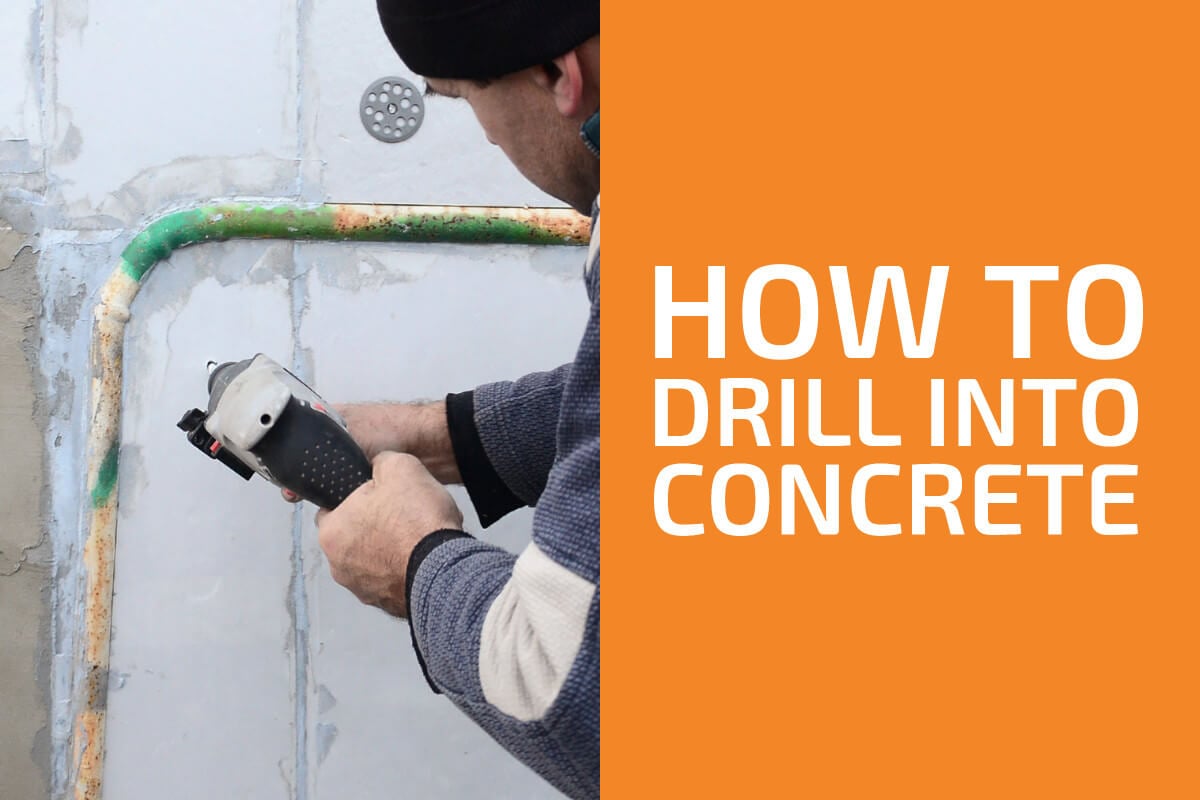
Whether you are a DIYer or a contractor, one of the most common tasks you will have to do is drilling into concrete. That said, with many different types of drills and drill bits available, it can be confusing choosing even a place to start.
In this article, I will help you with the process from the very beginning until the very end. Keep on reading.
What Is the Best Type of Drill for Drilling into Concrete?
There are two main types of drills that work best for drilling into concrete: hammer drills and rotary hammers. While these two are by far the ideal tools for the job, if you don’t have either of them, it doesn’t necessarily mean that you have to run to the hardware store.
That’s because you can also use a regular drill to drill holes in concrete. You’ll need more time and patience along with a wide range of drill bits when you’re using a regular drill but it is possible. The regular drills that are used on any construction or job site don’t have quite the power to push through the concrete but they’ll work in a pinch.
In this article, however, we will focus on using either of the two types of hammer drills. Before continuing, let’s take a closer look at both.
A regular hammer drill has two discs inside the spinning mechanism. These discs have ridges that allow the discs to slide past one another, catching on the opposing ridges. Once these two discs have caught each other, it results in a pounding effect that makes the drill rise and fall. For many hammer drills, you can turn off the hammering action and simply use them as a regular drill.
Rotary hammers create the pounding effect needed to bite into concrete by using a piston driven by a crankshaft. The piston rides in a cylinder and this creates air pressure that drives the hammer mechanism forward.
Between the two types of drills, the rotary hammer gives you a lot more power and precision for drilling through concrete in a hurry.
What Type of Drill Bit Do You Need to Drill into Concrete?
For a hammer drill, you’ll want to look for drill bits that are equipped with carbide tips and that have quality shanks that will keep them secure in the drill’s chuck. This secure attachment reduces overall breakage if it’s being used heavily. These types of bits are fairly affordable and work well for light masonry and drilling holes in bricks, mortar, and concrete blocks. You can check my recommendations here.
When it comes to rotary hammers, the most popular type of bits is SDS Plus bits which have grooves on their shanks that allow them to lock securely in place without impeding movement. In addition to the standard bits used to drill into concrete, you can add and purchase a wide array of other attachments to finish a job with your rotary drill. I talk about my favorite SDS bits sets here.
How to Drill into Concrete
With the two big questions out of the way, let’s take a look at the process itself.
Step 1: Measure and Mark
Measure and mark the spot on the concrete where you want to drill a hole. If it’s naked concrete, using some chalk will work the best. Alternatively, you can use a pencil.
Before you start drilling, be sure there’s no infrastructure behind or beneath the concrete that you might damage with the drill bit.
Step 2: Prepare Your Drill and Wear PPE
The next step is all about preparing your drill. You’ve got your spot marked on the concrete and now it’s time to ensure that your drill is ready to go.
Set the depth stop on the drill to 1/4 –inch longer than the depth you need your overall hole to be. Many new styles of hammer drills and rotary hammers will have these depths stops included but if not, use a piece of tape to mark where you need to stop on the drill bit itself.
Put on your safety goggles, gloves, ear protection, and mask before moving on.
Step 3: Drill a Pilot Hole
When you’re working with concrete screws, the right size drill bit is often included in the pack. Otherwise, you’ll need to determine the correct size drill bit before proceeding.
Before drilling your entire hole, you’ll want to put it in a guide hole. To do this, start by making sure all of your safety equipment is in place. Then ensure you have a stable stance, bracing the drill (if it doesn’t have an auxiliary handle) on the back and positioning it over the mark you made on the concrete.
Start at the slowest speed possible for the best control. Drill forward with a light, steady pressure, and don’t force the drill into the concrete. Drill this guide hole to 1/8-1/4 inch depth then pull out the drill and sweep or blow away the accumulated concrete dust.
For doing this, you will want to use a drill bit that’s smaller than your intended hole.
Step 4: Drill the Hole
Replace the drill for the final size, start the drill, and push forward with firm but not heavy pressure to start drilling the desired hole in your concrete. Run your drill at a slow to medium speed, pulling it out occasionally to remove any concrete dust that may have started to accumulate.
Once the hole is the right depth, remove the drill and brush or blow away any dust so the hole is free from obstruction. Now you’re ready to add your screws or other anchors as needed.
Mistakes to Avoid, Tips & Tricks
In addition to following the above process, you should also keep in mind the following tips when drilling into concrete.
Use Water
When you’re drilling into concrete, water is your friend. Wetting down the concrete before drilling can help cut down on dust or prevent your tools and the concrete itself from overheating.
Just make sure that you are not putting the water into contact with any parts that electricity is flowing through.
Keep Things Clean
As you’re drilling, move the drill bit in and out of the hole to clear away dust. This gives you a better view to know the depth you’re drilling to as well as if there might be any obstructions coming up in the path of your drill.
For cleaning dust, it’s best to use a blower or a vacuum.
Be Prepared for Jams to Happen
No matter how well you prepare, there are some things your hammer drill or rotary hammer just won’t bust through. If you happen upon an obstruction like aggregate or rebar within the concrete, back your drill out of the hole and put a masonry nail into it, and hammer on the nail head to break apart whatever’s blocking your way.
Even with these methods, you may just have to drill in a new spot so you won’t hit the obstruction again.
To avoid this as much as possible, you might want to locate rebar before you start drilling.
Safety First
While it may not be the most comfortable to wear, your safety equipment is one of the most important pieces of any job.
Make sure to use a mask, safety goggles, and gloves when drilling through concrete.
Summary
You’ve been on the job for a while but now you’re faced with a new problem: drilling into concrete. Before you jump up to tackle the job, you want to be sure you have the right tools to get it all done.
The first thing you’ll need is a hammer or rotary hammer. While a regular drill can get the job done, having a specialized tool will make the job much easier and it’ll take way less time. Secondly, you’ll want to be sure you have the appropriate bits and attachments to drill into the concrete. If you’re adding certain screws to your concrete project, many of the sets come with the appropriate drill bit included. Lastly, take your time putting the hole into your concrete. Mark the initial depth by using a depth finder setting on your drill or marking the correct depth with a piece of tape. Then drill your necessary hole, working out any obstructions along the way.
Once you’re finished with drilling your hole in the concrete, remove any concrete dust, attach your screws or anchors and you’re good to go. Drilling a hole in concrete all comes down to the right tools and a little bit of patience while drilling.
Investing in a hammer or rotary hammer is a great way to give yourself a leg up. Instead of spending time and energy trying to get a hole drilled in the concrete with your regular drill, you can spend a little bit more and get a tool that will speed up the process.




